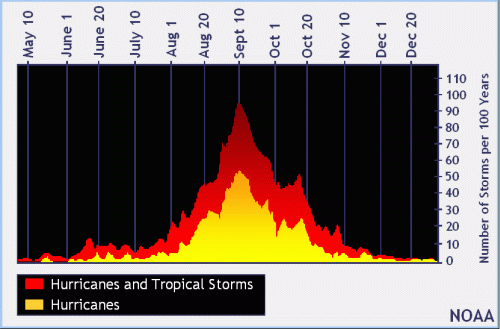
The end of the unusually quiet Atlantic hurricane season of 2013 is at hand. The final tally of thirteen named storms was above the average of eleven for a season, but the two hurricanes (Ingrid and Humberto) and zero major hurricanes were well below the average from 1950 - 2012 of six and three, respectively. The 2013 season ranked as the sixth-least-active Atlantic hurricane season since 1950, in terms of the collective strength and duration of named storms and hurricanes (ACE index), which was just 33% of the 1981 - 2012 average. The 2013 hurricane season was the first time since 1994 no major hurricanes formed, and was only the third below-normal season since the high-activity period for Atlantic hurricanes began in 1995. NOAA and the U.S. Air Force Reserve flew 45 hurricane hunter aircraft reconnaissance missions over the Atlantic basin this season, totaling 435 hours--the fewest number of flight hours since at least 1966, said NOAA in a press release summarizing the 2013 hurricane season.
Worst storm of the season: Ingrid
Mexico took a severe beating in 2013, with eight landfalling storms: one hurricane (Ingrid) and two tropical storms (Barry and Fernand) from the Atlantic side, and two hurricanes (Manuel and Barbara), and three tropical storms from the Pacific side. The deadliest and most expensive Atlantic storm of 2013 was Hurricane Ingrid, which weakened to a tropical storm with 65 mph winds before hitting Mexico about 200 miles south of the Texas border on September 16, 2013. Ingrid's heavy rains triggered flooding that killed 23 and did $1.5 billion in damage, making the storm the 7th costliest tropical cyclone in Mexican history. Barry and Fernand, which both hit the Mexican coast in the Gulf of Mexico between Tampico and Veracruz, dumped torrential rains and triggered floods that killed five and fourteen people, respectively. The first storm of the season, Tropical Storm Andrea, was the only named storm to make landfall in the United States this year. Andrea brought tornadoes, heavy rain, and minor flooding to portions of Florida, eastern Georgia and eastern South Carolina, causing one fatality and damage less than $25 million. No other deaths were recorded from Atlantic named storms in 2013. Tropical Storm Chantal did minor damage on Dominica and Martinique in the Lesser Antilles, and Tropical Storm Gabrielle did minor damage on Bermuda.
Figure 1. The strongest Atlantic hurricane of 2013, Category 1 Hurricane Ingrid, lays siege to Mexico on September 15, 2013. Ingrid killed 23 and did $1.5 billion in damage to Mexico. On the Pacific side, we see Tropical Storm Manuel, which killed 169 people and did $4.2 billion in damage to Mexico. Image credit: NASA Earth Observatory.
A preseason forecast bust
It was a bad year to be in the seasonal hurricane forecast business. All of the pre-season forecasts called for at least 7 hurricanes, 3 major hurricanes, and an ACE index at least 30% higher than average. With the actual numbers being 2 hurricanes, 0 major hurricanes, and an ACE index of just 33% of average , these forecasts were a major bust. The only pre-season forecast that one could deem successful was issued by a team at Penn State, led by Dr. Michael Mann, who only attempted to predict the number of named storms (they said 12 - 20, with a best estimate of 16.) The preseason forecasts largely failed because many of the factors that usually lead to active seasons that we can look at months beforehand all pointed towards an active season....MUCH MORE